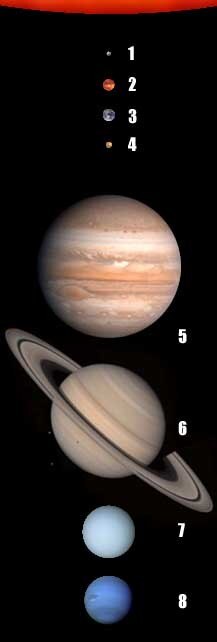Difference between revisions of "AY Honors/Stars/Planet/es"
(Created page with "<noinclude> thumb|right|150px|The Eight Planets: 1-Mercurio 2-Venus 3-La Tierra 4-Marte 5-Júpiter 6-Saturno 7-Urano 8-Neptuno '''Respuesta corta''...") |
(Created page with "'''Respuesta larga''' Lo creas o no, hasta el año 2006 no había una definición científica formal de la palabra ''planeta''. La mayoría de nosotros nos han enseñado que h...") |
||
| Line 4: | Line 4: | ||
Un planeta es un cuerpo grande que orbita una estrella, y domina las inmediaciones de su órbita. | Un planeta es un cuerpo grande que orbita una estrella, y domina las inmediaciones de su órbita. | ||
| − | ''' | + | '''Respuesta larga''' |
| − | + | Lo creas o no, hasta el año 2006 no había una definición científica formal de la palabra ''planeta''. La mayoría de nosotros nos han enseñado que hay nueve planetas: Mercurio, Venus, la Tierra, Marte, Júpiter, Saturno, Urano, Neptuno y Plutón. Los asteroides eran a la vez también considerado como planetas pero los científicos se dieron cuenta de que eran diferentes - había montones y montones de ellos y todos estaban en la misma región general del sistema solar, compartiendo órbitas entre Marte y Júpiter. Plutón no fue descubierto hasta 1930 y pronto fue anunciado como el noveno planeta. Pero la tecnología ha mejorado y los científicos empezaron a descubrir que había un montón de otros órganos mucho como Plutón en esa misma región del sistema solar (llamado el Cinturón de Kuiper). Con el tiempo se hizo evidente que Plutón nunca debería haber sido llamado un planeta, pero en el momento en que sucedió, Plutón ya era muy conocido. La cultura popular no permitiría a los científicos a «degradar» a Plutón a la condición de no-planetario. Así que los científicos lo dejaron solo. Después de todo, ninguno de los otros objetos del Cinturón de Kuiper eran tan grandes como Plutón, por lo que el problema se podía ignorar. | |
In 2005 an object named Eris was discovered in the Kuiper Belt beyond the orbit of Pluto. And it is larger than Pluto. The discovery of Eris forced the scientific community to come up with a formal definition of the word "planet," and that definition corrected the misclassification of Pluto as a planet. | In 2005 an object named Eris was discovered in the Kuiper Belt beyond the orbit of Pluto. And it is larger than Pluto. The discovery of Eris forced the scientific community to come up with a formal definition of the word "planet," and that definition corrected the misclassification of Pluto as a planet. | ||
Revision as of 21:30, 12 March 2015
Respuesta corta Un planeta es un cuerpo grande que orbita una estrella, y domina las inmediaciones de su órbita.
Respuesta larga Lo creas o no, hasta el año 2006 no había una definición científica formal de la palabra planeta. La mayoría de nosotros nos han enseñado que hay nueve planetas: Mercurio, Venus, la Tierra, Marte, Júpiter, Saturno, Urano, Neptuno y Plutón. Los asteroides eran a la vez también considerado como planetas pero los científicos se dieron cuenta de que eran diferentes - había montones y montones de ellos y todos estaban en la misma región general del sistema solar, compartiendo órbitas entre Marte y Júpiter. Plutón no fue descubierto hasta 1930 y pronto fue anunciado como el noveno planeta. Pero la tecnología ha mejorado y los científicos empezaron a descubrir que había un montón de otros órganos mucho como Plutón en esa misma región del sistema solar (llamado el Cinturón de Kuiper). Con el tiempo se hizo evidente que Plutón nunca debería haber sido llamado un planeta, pero en el momento en que sucedió, Plutón ya era muy conocido. La cultura popular no permitiría a los científicos a «degradar» a Plutón a la condición de no-planetario. Así que los científicos lo dejaron solo. Después de todo, ninguno de los otros objetos del Cinturón de Kuiper eran tan grandes como Plutón, por lo que el problema se podía ignorar.
In 2005 an object named Eris was discovered in the Kuiper Belt beyond the orbit of Pluto. And it is larger than Pluto. The discovery of Eris forced the scientific community to come up with a formal definition of the word "planet," and that definition corrected the misclassification of Pluto as a planet.

